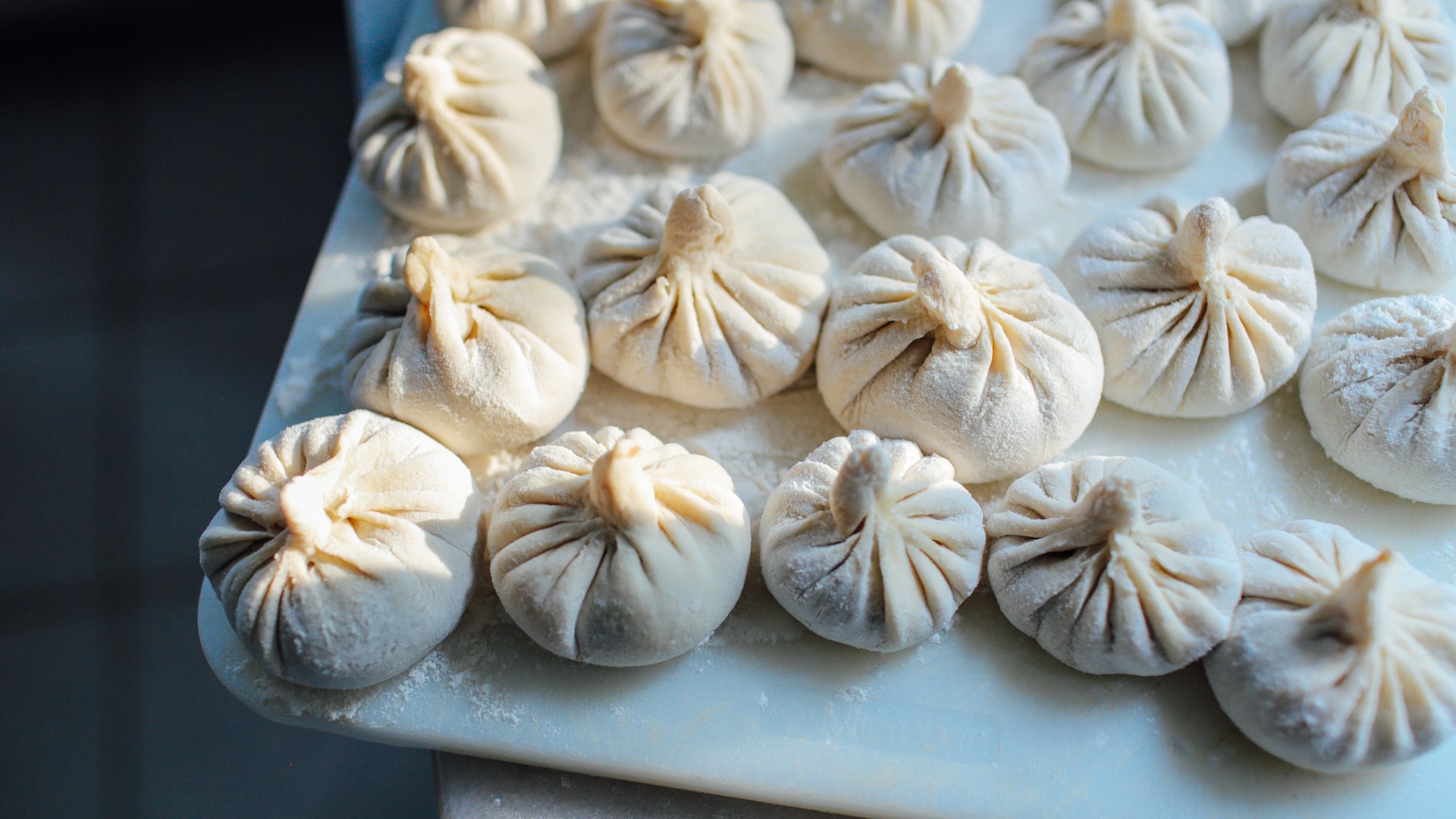SEATTLE — Polina Chesnakova traces her roots back to the Republic of Georgia. She grew up on traditional Georgian meals at family gatherings and her love of the cuisine into a career as a food & recipe writer. She's sharing her recipe for these delicious Georgian Soup Dumplings.
Recipe: Polina Chesnakova's Khinkali
Makes about 20 dumplings
Ingredients
Dough
- 420g all-purpose flour, plus extra for dusting
- 1 teaspoon kosher salt
- 1 cup tablespoons lukewarm water
Filling
- ½ pound ground beef
- ½ pound ground pork
- 1 medium onion, peeled and roughly chopped
- 1 cup cilantro, leaves and stems
- 2 tablespoons parsley, leaves and stems
- 1 teaspoon red pepper flakes
- ¾ teaspoon ground cumin
- 2 teaspoons kosher salt, plus more to taste
- 1 cup cold water
- Freshly cracked black pepper, to garnish
- Butter or sour cream, to garnish
Instructions
To make the dough, measure out flour into a large bowl. Make a well and add salt and warm water. Gradually mix in the flour with a large spoon or spatula until it becomes one large, shaggy mess.
Knead the dough on a well-floured work surface, adding more flour if the dough becomes sticky, for a good 10 minutes. You want the dough to become smooth and elastic—springing right back when you poke at it. Transfer to a floured plate and cover with a damp clean kitchen towel. Allow to rest for 30 minutes.
Meanwhile, to make the filling, place the meat in a large bowl. Into the bowl of a food processor, add the onion, cilantro, and parsley and pulse the mixture until onion and herbs are finely chopped and onion has released its juices. Add the onion-herb mixture to the meat, along with the spices and salt and mix, using your hand, to fully combine. Add water, a bit at a time, to the meat and continue to mix well until liquid is fully incorporated. Leave the mixture to stand for 30 minutes. Adding water here is important because it keeps the filling moist and juicy during the cooking process. It, in turn, soaks up the flavor and fat of the meat and becomes the wondrous broth the dumplings are known for.
Assembly
Cut the rested dough in half. Take one section (making sure the other one is covered) and roll it out on a floured work surface into a large circle, about 1/8-inch thick. You want the dough on the thicker side because you’ll be rolling it out again once you cut it into rounds. Another reason is because the meat-filling is heavy and wet—the last thing you would want is for the dough to break.
Use a glass or a cookie cutter about 3 inches in diameter and stamp out rounds from the dough—the remaining cut-outs can be combined and placed beneath the other covered sections. The rounds will shrink a bit so roll each out to about 4 inches in diameter.
Place one full tablespoon of filling in the center of each round. Using your fingers, take one edge and bring it in towards the center. Moving in a clockwise direction, begin folding the edges, allowing each fold of dough to overlap the previous one. In this way, continue to pleat and pinch as you go, until the filling is completely encased. The magic number of pleats is 19. Of course, this takes a lot of practice, so just do your best. As long as the top is tightly closed (you don’t want any juices leaking out!) that’s all that matter. To ensure a tight seal, firmly pinch the “neck.” Alternatively, pinch the neck and twist the pleats together while turning the dumpling the other way. Either way, you want to slightly tug the formed knot up to create a bit of space between the dough and filling. Transfer to a lightly floured plate or baking sheet. Cover with a damp kitchen cloth—you don’t want them to dry out. Repeat with remaining rounds and then repeat process with the remaining dough.
At this point, you can cook them all or just cook what you know you will eat and freeze the rest. Bring a large pot of well-salted water to a boil and, working in batches of 10, lower each khinkali into the pot, dangling it in the water the way I demoed in class. Give the khinkali a gentle stir with a spoon so that they don’t stick to the bottom or to each other. Once the pot is brought to a boil again, allow to cook for 8 to 10 minutes. Remove with a slotted spoon, place on a serving platter, and garnish with freshly ground black pepper. Serve with butter or sour cream*.
A Note on eating Khinkali
Before you pierce your khinkali with a fork, stop! You’re doing it all wrong. The whole art to eating khinkali is never allowing the broth to escape anywhere except for into your mouth. The topknot, never to be eaten, serves as your handle for holding the dumpling, as well as your way of keeping count how many you’ve consumed. So, choose the tastiest-looking khinkali and pick it up by its topknot with your fingers. Puncture the dough with a bite, releasing a stream of unctuous broth and happiness into your mouth. Slurp those juices and take the next bite, revealing juicy, tender meat. Devour the dumpling until all your left with is the doughy topknot. Continue to eat khinkali until your plate is littered with kudi—the person with the most, wins.
Polina is teaching classes on how to make Khinkali on March 19 and April 9 at Book Larder in Seattle.
Segment Producer Derek Haas. Watch New Day Northwest 11 AM weekdays on KING 5 and streaming live on KING5.com. Contact New Day.

